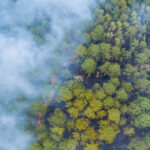Task 128
Pilot Applications of the Chesapeake Bay Forecast System
Principal Investigator(s):
A. Busalacchi
Sponsor(s):
J. Bryson
Last Updated:
October 26, 2012 15:25:30
Description of Problem
A project aimed at demonstrating the value and utility of applications of the Chesapeake Bay Forecast System (CBFS), a prototype regional integrated Earth System Model being developed and implemented at the University of Maryland Earth System Science Interdisciplinary Center. This pilot effort will develop several Pilot User Collaborations aimed at identifying and testing methods for applying CBFS forecast products to sector-specific needs.
Scientific Objectives and Approach
The project will be based on the Chesapeake Bay Forecast System (CBFS), a prototype regional ESM being developed at ESSIC. The CBFS dynamically downscales global climate forecasts at time scales from sub-daily to interannual and decadal. The CBFS consists of regional atmosphere, ocean, biogeochemical and land dynamical models that are coupled together to provide comprehensive forecasts of the environmental behavior of the Chesapeake Bay region.
Accomplishments
David Jasinski/Chesapeake Research Consortium reports that work in 2010 has been focused on development of a forecasting model for bacteria threshold violations in the James River and the organization of a workshop to highlight the capabilities of the Chesapeake Bay Forecasting System (CBFS) to Chesapeake Riverkeepers and watershed groups. For the forecasting model, there has been a great deal effort in obtaining bacteria and meteorological data for stations within the James River watershed and formatting the data to investigate relationships between precipitation events and bacteria threshold violations. Data were analyzed using multiple linear regression and logistic regression with no significant models identified. Current work on model development is focused on CART analysis and working with the ESSIC SWAT model team to determine bacteria loads from the James River SWAT model.
Catherine Wazniak/Maryland Dept. Natural Resources reports that they downloaded all the data from the server and have matched up grid cells with in situ data points so that they can start matching up the results. The objectives of this study are to assess the skill of the Chesapeake Bay Forecast system, CBFS, model in regards to harmful algae blooms, HABs, and to refine the habitat suitability model for Karlodinium associated with cryptophyte abundance.
Sujay Kaushal/UMCES (and now UMD ESSIC/Geology) reports that he has been compiling some long-term historical trends in nutrients and temperature at some of the sites (some data sets extend to almost 100 years) and will compare model forecasts with retrospective historical trends.
Molly Brown/NASA/GSFC reports that the project provided 1990s and 2050s monthly data to BWPFS partners, along with some interpretive figures and an explanation of what the data means. The partners were provided with precipitation, min and max temperature, relative humidity, downward solar radiation, upward water vapor flux and growing degree days. In conjunction with Dr. Marla Macintosh’s master’s degree student Stephanie Juchs at the University of Maryland, some analysis of the impact on local forests of the observed changes in temperature, precipitation and humidity expected over the next five decades was conducted. While overall growing season may be lengthened for plant communities as a whole (as suggested by the increase in minimum temperature and growing degree days) response to these changes are species and population specific and the literature suggests life histories of certain species may actually shorten. This is due to the fact that earlier greening could lead to earlier flowering and senescence. There is a major theme in the literature about asynchrony between species and their pollinators. These shortened life histories also could result in community divergence due to seasonal niche divergence. The literature also suggests a warmer and wetter pattern for the Eastern United States which is not necessarily reflected in the CBFS model (Max. temp data and the variable precipitation data). With this pattern it is expected that suitable habitat will increase for many species but this does not mean that species will come to occupy these sites. It is expected that changes in species distribution and range will occur independently leading to the formation of new community types. Losses are thought to occur in aspen-birch and maple-beech-birch habitats with gains in oak-pine and oak-history forest types. Changing habitats are highly correlated with increasing amounts of disturbance so pests, diseases, and invasive species are thought to be on the rise. Minimum temperature is also important for pest outbreaks. Taking the general accuracy of the model into account, the model shows the overall variation to be expected with climate change on a downscaled level. The indirect effects such as pest and disease outbreaks are likely to be far more influential than the direct effects of temperature and precipitation.
Researchers at UMCES and NOAA Oxford Lab report that the working hypothesis for this project is based on a modified version of Cushing’s match-mismatch. They have modified the hypothesis a little bit for Chesapeake Bay striped bass to state that overlap between fish larvae and ABUNDANT, HIGH QUALITY zooplankton prey enhances fish feeding success, growth, and survival. This is a major explanation for how climate variability can affect population dynamics. This is an ongoing collaborative project, which strategically leverages the institutional and human expertise, resources, and capabilities of NOAA’s Cooperative Oxford Lab, and its partners. In addition, they have been working closely with the Maryland Department of Natural Resources, and the Maryland Sea Grant to ensure the outcomes of this project are useful to ecosystem-based fisheries management.
The CBFS End-user Workshop was held September 2 at ESSIC (see agenda below). Riverkeepers from the Choptank, Chester, and James Rivers were in attendance as well as a representative from the Anacostia Watershed Society. There were several presentations made about the capabilities of the CBFS. Feedback from attendees was positive with general interest in working with ESSIC to obtain CBFS output in formats tailored to suit their needs. Future work will focus on assisting the Riverkeepers in these efforts.
Task Figures
| Fig. 1 – |





